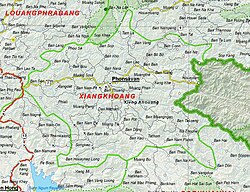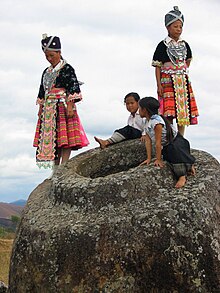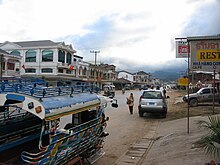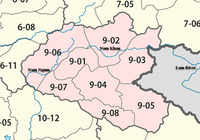Xiangkhouang
 From Wikipedia - Reading time: 16 min
From Wikipedia - Reading time: 16 min
This article needs additional citations for verification. (November 2020) |
Xiangkhouang province
ແຂວງ ຊຽງຂວາງ | |
|---|---|
 Phonsavan Hills | |
 Map of Xiangkhouang province | |
 Location of Xiangkhouang province in Laos | |
| Coordinates: 19°25′0″N 103°30′0″E / 19.41667°N 103.50000°E | |
| Country | Laos |
| Capital | Phonsavan |
| Area | |
• Total | 14,751 km2 (5,695 sq mi) |
| Population (2020 census) | |
• Total | 267,172 |
| • Density | 18/km2 (47/sq mi) |
| Time zone | UTC+7 (ICT) |
| ISO 3166 code | LA-XI |
| HDI (2017) | high · 2nd |
Xiangkhouang (Lao: ຊຽງຂວາງ, meaning 'Horizontal City') is a province of Laos on the Xiangkhoang Plateau, in the nation's northeast.[2] The province has the distinction of being the most heavily-bombed place on Earth.[3]
Historically, the province was formerly the independent principality of Muang Phuan. Its present capital is Phonsavan. The population of the province as of the 2015 census was 244,684.[4]
Xiangkhouang province covers an area of 15,880 square kilometres (6,130 sq mi) and is mountainous. Apart from floodplains, the largest area of level land in the country is on the province's Xiangkhoang Plateau. The plateau is characterized by rolling hills and grassland whose elevation averages 1,300 metres (4,300 ft). The country's highest peak, Phou Bia (2,820 metres (9,250 ft)), rises at the south side of the plateau. Nam Et-Phou Louey is a National Biodiversity Conservation Area (NBCA) in the province, covering an area of 5,959 km2, and overlaps into Houaphanh and Luang Prabang provinces.
The province's Plain of Jars was designated as a UNESCO World Heritage Site in 2019.[5]
History
[edit]
While the origin of the Plain of Jars' people is unknown, the recorded history of Xiangkhouang is interlinked with the Tai Phuan. As an ancient civilization, its prehistory is linked to the enigmatic megalithic stone jars of the Plain of Jars (with prehistoric material dating back to 2,000 BCE, while the Iron Age period of 500 BCE and the more recent 500–80 CE period dominating archaeological finds) representing burial grounds.
The Tai Phuan or Phuan people are a Buddhist Tai-Lao ethnic group that migrated to Laos from southern China. According to the Pongsawadan Meuang Puan ("Muang Puan Chronicles"), they were the first people who migrated in the 13th century from China to settle this province, forming the independent principality of Muang Phuan on the Plain of Jars, with Xieng Khouang (contemporary Muang Khoun) as its capital. They established a prosperous overland trade in metals and forest products with India and China; the Xieng Khouang Plateau was the center of trade for a large area of upland Southeast Asia, extending as far as Da Nang in Vietnam, Samrong Sen in Cambodia, the Khorat Plateau in northeast Thailand, and the North Cachar Hills of northeastern India.[6]
In the mid-14th century, Muang Phuan was subsumed into the Lan Xang kingdom under King Fa Ngum.[7][6][8] Siamese invasions in 1777–1779, 1834–1836, and 1875–1876 sought to resettle the Phuan population into regions under firm Siamese control.[6] In subsequent years, Haw invaders and fleeing ex-Taiping Rebellion revolutionaries from China repeatedly looted both Xiangkhouang province and neighboring Luang Prabang.
In the 1890s, the province came under French colonial rule following the 1893 Franco-Siamese crisis. During the Second Indochina War of the 1960s and 1970s, the province was a major battleground in the Laotian Civil War, fought between royalist forces and the communist Pathet Lao until 1975, when the Pathet Lao emerged victorious and seized power over all of Laos. Xiangkhouang was the Lao province most bombed by the United States Air Force in support of royalist forces led by Hmong general Vang Pao, who was born in the province.[9] As a result of this extensive air campaign, Muong Khoun, the original capital of the province, was virtually razed to the ground, resulting in the capital being moved to Phonsavan. During the wars, most of the 16th–19th century temples were completely destroyed, with only Wat Phia Wat temple having partially survived.[6]
Geography
[edit]
Xiangkhouang province covers an area of 15,880 square kilometres (6,130 sq mi) and has a largely mountainous topography.[10] The province borders Luang Prabang province to the northwest, Houaphanh province to the northeast, Vietnam to the east, Bolikhamsai province to the southeast, and Vientiane province to the southwest. The capital is Phonsavan. Xiangkhouang and Vientiane provinces are part of the Nam Ngum River watershed.[11]
Apart from floodplains, the largest expanse of level land in the country is on the province's Xiangkhoang Plateau. This area is characterized by rolling hills and grassland whose elevation averages 1,300 metres (4,300 ft). The country's highest peak, Phou Bia (2,820 metres (9,250 ft)), rises at the southern side of the plateau, while the Plain of Jars is at the plateau's centre.[12]
The province is 400 km northeast of Vientiane. Phou Bia, at 2,700 m elevation, is the highest peak in the province, and the highest in Laos. The capital city is at an elevation of about 1,000 m above mean sea level (AMSL), with Kham District in a low-laying basin at an elevation of about 600 m AMSL.[13]
Protected areas
[edit]Nam Et-Phou Louey is a National Biodiversity Conservation Area (NBCA) which covers an area of 5,959 km2 in Xiangkhouang, Houaphanh, and Luang Prabang provinces.[14] The park consists mainly of mountains and hills, with elevations ranging between 336 and 2257 metres. The area is the source of many rivers. It is named after the Nam Et River and Phou Louey ("Forever") Mountain.[15]
The area has a high level of biodiversity, and a number of endangered species including tiger, leopard, clouded leopard, Asian golden cat, marbled cat, civet, gaur, Sambar deer, white-cheeked gibbon, sun bear, black bear, Asian elephant, dhole, hornbill and three species of otter.[15]
Administrative divisions
[edit]The province is composed of eight districts which cover a total land area of 15,880 square kilometres (6,130 sq mi).[13] Thathom District was moved to Xaisomboun province in January 2006.
| Map | Code | Name | Lao script |
|---|---|---|---|

| |||
| 09-01 | Pek District (Phonsavan) | ເມືອງແປກ | |
| 09-02 | Kham District | ເມືອງຄຳ | |
| 09-03 | Nong Het District | ເມືອງໜອງແຮດ | |
| 09-04 | Khoune District | ເມືອງຄູນ | |
| 09-05 | Mok May District | ເມືອງໝອກໃໝ່ | |
| 09-06 | Phou Kout District | ເມືອງພູກູດ | |
| 09-07 | Phaxay District | ເມືອງຜາໄຊ |
Economy
[edit]This section needs additional citations for verification. (August 2022) |

Xiangkhouang province is the main maize-producing area of Laos.[16] The centre for trade and tourism is Phonsavan. In the village of Ban Napia near Phonsavan, villagers re-use scrap metal from unexploded ordnance (UXO) to make spoons to be sold as souvenirs. The scrap metal is checked for safety beforehand by UXO Lao. This community-based project provides income for the villagers. As of 2012, three minor accidents involving UXO had been reported.[17]
Ethnic groups
[edit]Xiangkhouang is home to five different ethnic groups: the Tai Dam, Tai Daeng, Phuan, Khmu, and Hmong. Their traditional houses, dresses, beliefs and rituals are part of the cultural heritage of Laos. There are also minorities of Laotian Chinese and Vietnamese, as well as some international workers from South Korea, Japan, Europe and North America.[citation needed]
-
Hmong girls
-
Bullfight, Hmong New Year
-
Phuan girls in traditional clothing
Tai Dam
[edit]Tai Dam, Tai Daeng and Tai Phuan belong to the Tai language family, by far the most significant language in Laos, spoken by 60% of the national population. The Tai Dam migrated from northern Vietnam to Laos 80–300 years ago. They are not Buddhists. Instead, they practice a form of ancestor and spirit worship. Tai Dam are well known producers of fine quality silk and cotton textiles and some women export to overseae markets. Older Tai Dam women still wear the traditional blue indigo cotton shirt, skirt, and black turban woven with colored patterns. They produce rice alcohol, called lao lao that is consumed socially and used for ritual purposes.
Tai Dam settled in upland valleys near streams and irrigable and accessible plains scattered among Lao and Phuan villages. They built rectangular symmetric houses on pilings, with a rice granary under the house. Villages are composed of 15¬60 houses and are not fenced. The people subsist on wet rice, vegetables, poultry, weaving, sewing and hunting.
The ancestors of the Tai Phuan once founded the kingdom of the same name.[18]
Khmu
[edit]Part of the Mon-Khmer branch of the Austro-Asiatic linguistic family, the Khmu are one of the largest ethnic groups in Laos. They settled in the area several thousand years ago. The Khmu rapidly acculturated and there is now little in their clothing that distinguishes them from the surrounding Lao, although they speak a completely different language.
Khmu houses are built on stilts. Each village has a communal house where men gather for political discussions, or work together on basket making and other crafts. Like many ethnic groups in Lao the Khmu practice their own form of animism. The Khmu are well known for their skill at making baskets, fish traps, and other objects from bamboo. Their material culture, their tools, utensils, baskets and netbags reflect their continued reliance on the forest. Growing rice, hunting, gathering forest products and producing handicrafts provide some cash income. They distill lao hai ("jar alcohol").
Hmong
[edit]Hmong people migrated from China to Laos between 1800 and 1900. Having a strong desire for independence, they rebelled against Chinese attempts to control and settle them and fled in successive waves southwards. During the Lao Civil war in the 1960s and 1970s, Hmong were recruited by the CIA's "Secret Army", commanded by Hmong General Vang Pao. Hmong villages were relocated in free-fire zones, and many died during these evacuations or due to fighting. When the communists came to power in 1975, tens of thousands of Hmong fled to Thailand or emigrated to the US. Today, remittances from the diaspora are a major economic factor in the province, fueling significant construction activity.
The Hmong accounts for 6-10% of the total population of Laos, and remain most numerous and concentrated in eastern Xiangkhouang. In the province the White Hmong, the Striped Hmong, and the Green Hmong can be distinguished. The easiest way to differentiate these groups is by looking at the women's dresses.
Hmong live in forested mountains between 800 and 1,500 meters elevation, and in Laos they are categorized as Lao Soung ("highland people") although today there are more and more villages located in the lowlands. Hmong villages typically range in size from 15 to over 60 houses; they are not fenced and are organized by clan. The rectangular houses are on beaten soil and have one room without windows. The walls are made of vertical wood planks and bamboo and a thatched roof. Hmong are known for their knowledge of the forest, herbal medicines, and expertise in raising animals. Their agricultural system is based on rain-fed slope cultivation with slash-and-burn techniques. They live on rice, corn and vegetable production, swine and poultry husbandry, gathering, hunting, embroidery, and basket work.
Their religion is a form of shamanistic animism with a cult of ancestors and spirits, and a belief in three souls. Certain spirits protect the people within the village boundaries, while others maintain their influence over the plant and animal kingdom outside the village.
Hmong women are renowned for their embroidery and weaving. Traditionally, clothes are made from hemp and cotton. Batik, used only by Green Hmong for their distinctive skirts, is a very long process. Before dying, the cloth the pattern is marked with wax. The wax is then removed to reveal the pattern. The wax is applied with a batik pen and the design is completed square by square. Many distinct geometric patterns exist, and they are passed on from mother to daughter. The material is pleated by running a sharp-edged stone along the pleat lines on alternate sides of the cloth, and sewing the poles into place at the waistband. These skirts and many other items of Hmong clothing are also embroidered. Embroidery and applique is a social activity, a time for women to sit together and exchange views and news.
Hmong New Year celebrations in December, starting from the 15th day of the ascending moon, are accompanied by numerous activities including top-spinning competitions, dances, songs, and bull fights. It is one of the main occasions for finding a wife or a husband. The young men and women toss the makkono, a small fabric ball, as part of a courting ritual which can go on for hours. During the festivities, Hmong women wear their traditional dresses, adorned with intricate embroidery and silver jewelry.
Landmarks
[edit]The tourism department of Laos has listed 63 notable landmarks in the province. 32 are natural sites, 18 are cultural sites, and 13 are historical sites.[13] Of these, some of the important sites are the following:[19]

The province's most distinctive landmark is the Plain of Jars. The "jars" are 2,100 tubular-shaped megalithic stone jars used for funerary purposes. The jars range from 1–3 metres (3 ft 3 in – 9 ft 10 in) in height. They are found throughout the province in clusters containing from one to several hundred jars each. The jars date from the Iron Age (500 BCE–500 CE).[20] Nearest to Phonsavan is Jar Site 1, with an area of 25 hectares (ha). The largest jar found here is 2.5 m x 2.5 m, while the rest are half this size. One jar has decorations on it.[19][21] The megalithic jar sites of Xiangkhouang were inscribed on UNESCO's list of World Heritage Sites in July 2019.[20]

Muang Khoun was the capital of the ancient Phuan Kingdom of the 14th century. It is southeast of Phonsavan. At the Wat Phia Wat Temple, destroyed during the conflicts of the First Indochina War (1946–1954) and the Second Vietnam War (1955–1975), the ruins of a stone wall with brick archways, relics of French colonial rule of over this part of Laos and from the whole country, a large statue of Buddha, broken pillars and short sections of walls remain to this day and are still clearly visible as well as accessible. Once buried in the thick tropical forest, the That Foun stupa, dating back some 450 years, can be seen near the road outside Phonsavan.[19] In an ethnic village of the Phuan, to the south of Phonsavan, Ban Napi mounds of war scrap can be seen buried in tableware. During the 1980s, eight families came together and assembled bits and pieces of aluminum from damaged, crashed or shot-down United States Air Force aircraft, as well as aircraft from US-aligned air forces (such as the Royal Lao Air Force) in mounds of melted metal, lack, wood and ash. Such war debris and wreckage can be found scattered between the Lang Waterfall and Jar Site 3 of the Plain of Jars.[19]
A secret tunnel was constructed below the hills of the Phu Kheng Jar Quarry Site during the Second Indochina War. The tunnel is 70 metres (230 ft) in length and 1.6 metres (5 ft 3 in) in height. Reinforced-concrete bunkers with night-camps are visible nearby.[19] Unexploded ordnance can be found in large quantities in this Laotian province, and these are all in the process of being cleared and removed under the aegis of the United Kingdom-based Mines Advisory Group (MAG). The Visitor Information Centre established by the MAG in Phonsavan provides information on the history of the aerial bombardment campaigns in this part of Laos.
See also
[edit]References
[edit]- ^ "Sub-national HDI - Area Database - Global Data Lab". hdi.globaldatalab.org. Retrieved 13 September 2018.[not specific enough to verify]
- ^ "Base Map:Lao People's Democratic Republic (LPDR". UNOSAT. Retrieved 4 December 2012.
- ^ Gilhooly, Rob (5 July 2000). "The Plain of Jars: A place of war and death". The Japan Times. Retrieved 16 May 2020.
- ^ "Provinces of Laos". Statoids. Retrieved 1 November 2012.
- ^ "Megalithic Jar Sites in Xiengkhuang – Plain of Jars". UNESCO. Retrieved 24 April 2021.
- ^ a b c d "Xieng Khouang History". Tourism Marketing Department, Lao PDR. Archived from the original on 1 July 2014. Retrieved 6 December 2012.
- ^ Provincial Tourism Department Xieng Khouang, A Guide to Xieng Khouang
- ^ Stuart-Fox, Martin (1998). The Lao Kingdom of Lān Xāng: Rise and Decline. White Lotus Press. ISBN 9789748434339. Retrieved 18 November 2020.
- ^ Cranmer, Jeff; Martin, Steven; Coxon, Kirby (1 November 2002). Laos. Rough Guides. pp. 199–. ISBN 978-1-85828-905-2. Retrieved 11 December 2012.
- ^ "Xiengkhouang Province". Lao Tourism Organization. Archived from the original on 12 September 2012. Retrieved 3 December 2012.
- ^ Ahmed, M.; Hirsch, Philip (2000). Common Property in the Mekong: Issues of Sustainability and Subsistence. The World Fish Center. p. 62. ISBN 978-971-802-008-1.
- ^ Mansfield, Stephen; Koh, Magdalene (1 September 2008). Laos. Marshall Cavendish. p. 9. ISBN 978-0-7614-3035-3. Retrieved 3 December 2012.
- ^ a b c "Xieng Khouang Overview". Tourism Marketing Department, Lao PDR. Archived from the original on 1 July 2014. Retrieved 6 December 2012.
- ^ Kamler, Jan (10 November 2010). "The Ecology of Dholes in a Zoned Reserve in Laos". The Rufford Foundation. Retrieved 16 May 2020.
- ^ a b "Nam Et–Phou Louey National Protected Area". Nam Et–Phou Louey National Protected Area / Wildlife Conservation Society. 1 December 2012. Archived from the original on 4 April 2012.
- ^ Lao People's Democratic Republic: Second Poverty Reduction Strategy Paper (EPub). International Monetary Fund. 21 October 2008. p. 54. ISBN 978-1-4527-9182-1. Retrieved 6 December 2012.
- ^ "War Spoon Village Ban Napia". Tabeaglahs.wordpress.com. Retrieved 11 December 2012.
- ^ "Mekong Lao Phuan Profile". Archived from the original on 25 June 2009. Retrieved 17 May 2020.
- ^ a b c d e "Highlights in Xieng Khouang". Tourism Marketing Department, Lao PDR. Archived from the original on 28 May 2013. Retrieved 18 November 2020.
- ^ a b "Megalithic Jar Sites in Xiengkhuang – Plain of Jars". UNESCO World Heritage Centre. UN. Retrieved 24 April 2021.
- ^ "Xiengkhouang Province". The Lao National Tourism Administration. Archived from the original on 29 August 2012. Retrieved 6 December 2012.
Further reading
[edit]- Kurlantzick, Joshua (2017). A Great Place to Have a War; America in Laos and the Birth of a Military CIA. Simon & Schuster. ISBN 978-1-451-66786-8. Retrieved 18 November 2020.
- Lehmann, Jean-Pierre (March 2017). "A Look Back at the CIA's Dirty War in Laos". Forbes Asia. Retrieved 18 November 2020.
- Fagotto, Matteo (31 January 2015). "Laos: Thousands suffering from the deadly aftermath of US bomb campaign". The Guardian. Retrieved 18 November 2020.
External links
[edit] Phonsavan travel guide from Wikivoyage
Phonsavan travel guide from Wikivoyage Plain of Jars travel guide from Wikivoyage
Plain of Jars travel guide from Wikivoyage- Tragic Legacy: Profound Mystery – The Unknown Story of Xieng Khouang by Mike Matsuno
 KSF
KSF

